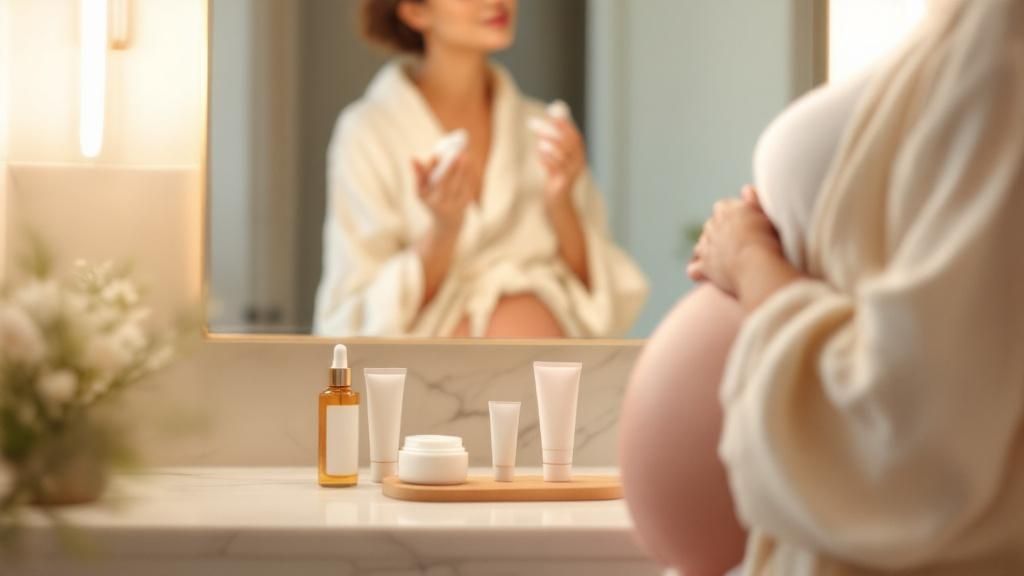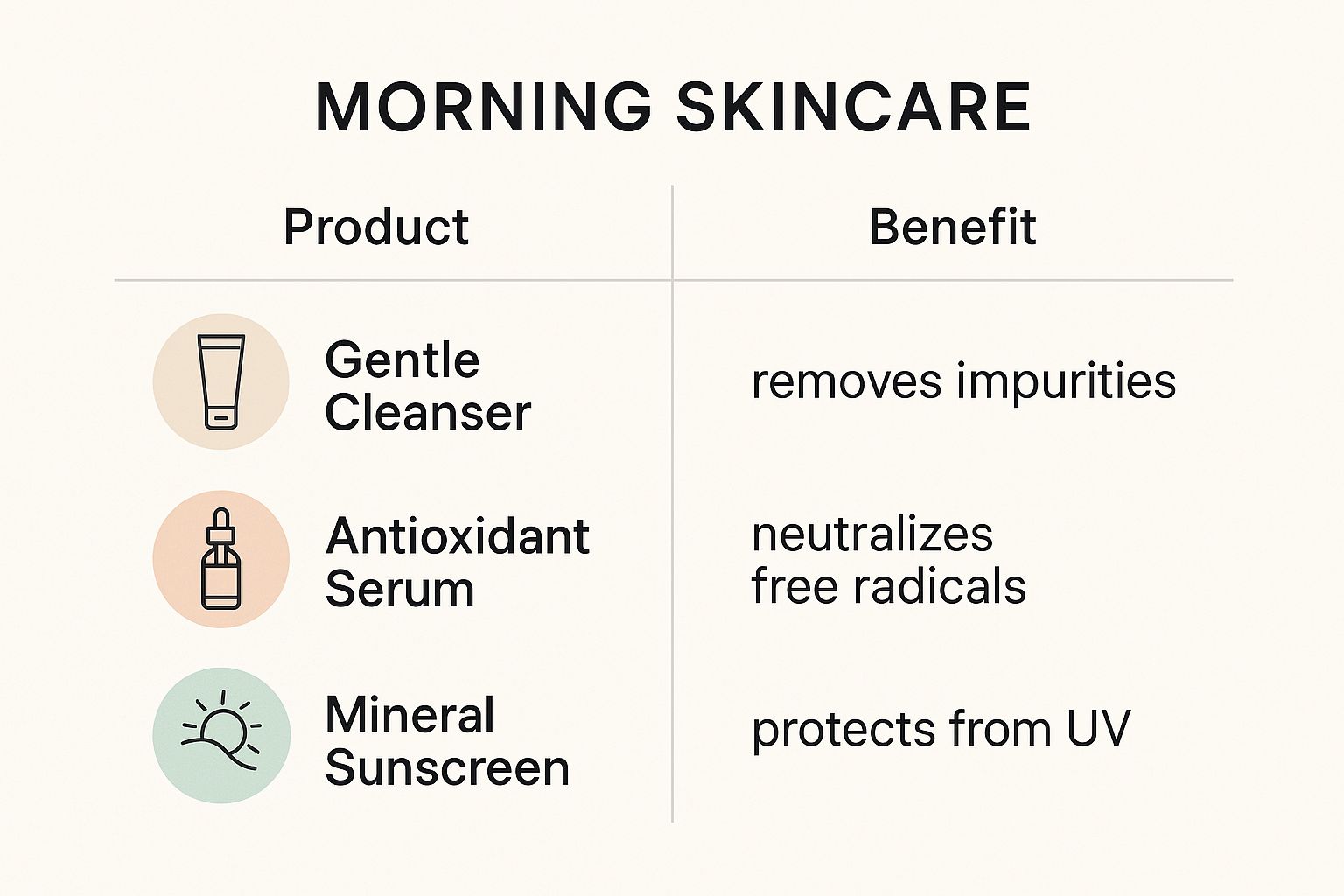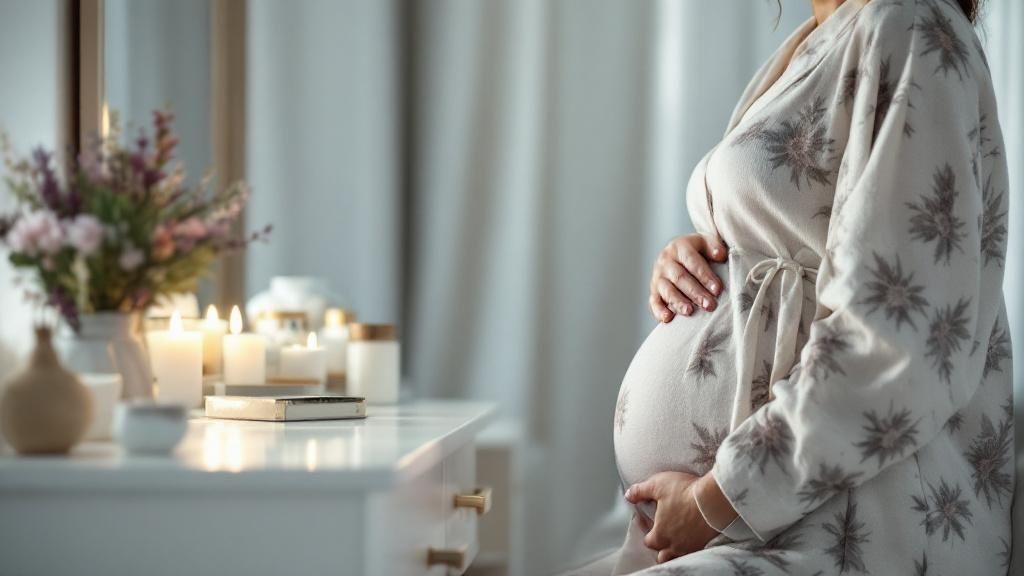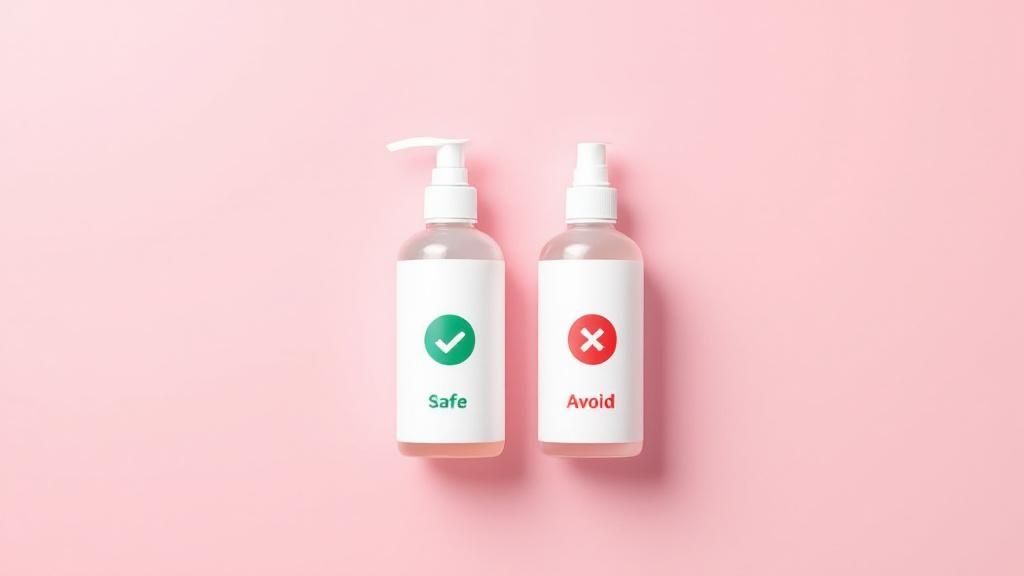
Your skin is going through a lot right now, and building a solid pregnancy skincare routine starts with understanding why. The goal isn't to fight the changes, but to work with them using gentle, safe ingredients that can calm hormonal acne and soothe new sensitivities.
Think simplicity and consistency. This is the time to nourish and protect your skin, not overwhelm it with a dozen different products. A streamlined routine is far more effective and supportive for the journey ahead.
How Your Skin Changes During Pregnancy

Pregnancy is a time of incredible transformation, and your skin is often the first place you’ll see those internal shifts happening in real time. Fluctuating hormones are behind everything—from that coveted "pregnancy glow" to more challenging issues like melasma and breakouts. Getting a handle on this connection is the key to creating a routine that actually works.
So, about that glow. Increased levels of estrogen and progesterone boost your blood circulation, which can give some expecting moms a gorgeous, rosy complexion. But those same hormones can also kick your oil glands into high gear, leading to clogged pores and hormonal acne, especially along the jawline. If your skin suddenly feels like it’s having a teenage throwback moment, you are definitely not alone.
Understanding Common Skin Shifts
Beyond acne, you might notice a few other new things popping up. Heightened sensitivity is a huge one. Products you've used for years might suddenly cause irritation or redness, and that's because your immune system is a little suppressed, making your skin more reactive.
Another major change is hyperpigmentation, which usually shows up in two ways:
- Melasma: Often called the "mask of pregnancy," these are dark, blotchy patches that can appear on your forehead, cheeks, and upper lip. Sun exposure makes melasma much, much worse, so diligent sun protection is absolutely non-negotiable.
- Linea Nigra: This is the dark vertical line that runs from your belly button down to your pubic area. It's a completely normal hormonal effect and almost always fades after delivery.
With so many women looking for safe ways to manage these changes, the market has exploded. The global pregnancy skincare products market was valued at around $2 billion and is expected to grow at a compound annual growth rate (CAGR) of 7%. This just shows how many of us are actively seeking effective, pregnancy-safe solutions. You can discover more insights about this growing market and what's driving it.
The Foundation of a Pregnancy Skincare Routine
Here’s the good news: you don't need a complicated, 10-step regimen. In fact, the opposite is true. During pregnancy, the best approach is built on three simple principles: safety, simplicity, and consistency. Your goal is to support your skin's barrier, not strip it.
This is the perfect time to pare back your routine to the essentials. Think of it as a reset, focusing on gentle formulas that calm, hydrate, and protect your skin without causing additional stress.
This all starts with the very first step—cleansing. A mild, hydrating cleanser is crucial for washing away impurities without disrupting your skin’s natural moisture balance. It creates a calm, clean canvas for the rest of your products.
For this foundational step, you need something designed with sensitivity in mind. The [BARB N.P. gentle hydrating cleanser](https://barbnp.shop/products/gentle-hydrating- cleanser) is a perfect example of a product that respects the skin’s delicate state during pregnancy. It cleanses effectively while providing soothing hydration, making it an ideal anchor for your new, simplified routine. From here, you can thoughtfully build out the rest of your regimen to address your specific concerns.
Decoding Skincare Ingredients For A Safe Routine
Reading a product label can feel like a high-stakes exam when you're pregnant. Suddenly, every single ingredient seems to carry more weight. The goal here isn't to create fear, but to empower you with a clear, safe guide on what to embrace and what to temporarily set aside.
Knowing which ingredients are your allies helps you confidently choose products that will nourish your skin and protect your baby. Let’s break it down.
The Green-Light Ingredients For Glowing Skin
During pregnancy, your skin often craves two things: hydration and gentle brightening. These ingredients are fantastic for delivering both, safely and effectively. Think of them as your new best friends.
-
Hyaluronic Acid: A true hydration superstar. It’s naturally found in your skin and can hold up to 1,000 times its weight in water, making it perfect for quenching that pregnancy-induced dryness without clogging pores. The BARB N.P. HYDRASOOTHE SERUM is packed with hyaluronic acid to deliver intense, yet lightweight, hydration.
-
Vitamin C: This powerful antioxidant is your first line of defense against environmental damage. It also helps brighten your complexion and is a fantastic tool for managing the melasma (the "mask of pregnancy") that sometimes appears.
-
Niacinamide (Vitamin B3): A versatile multi-tasker that's perfect for hormonal skin. It calms inflammation and redness, minimizes the appearance of pores, and supports your skin's all-important moisture barrier.
-
Azelaic Acid: Often recommended by dermatologists, azelaic acid is a safe and effective choice for tackling hormonal acne and redness. Its anti-inflammatory and anti-bacterial properties are a game-changer for keeping breakouts under control.
This simple visual breaks down the core of a solid morning routine, all built with safe and effective ingredients.

As you can see, a gentle cleanser, an antioxidant serum, and a mineral sunscreen are all you need to prepare and protect your skin for the day. This simple, three-part system is the foundation of a protective morning regimen.
Ingredients to Pause During Pregnancy
Just as important as knowing what to use is knowing what to avoid. Some of the most popular skincare powerhouses are best left on the shelf until after you’ve delivered and finished breastfeeding. This is purely a precautionary measure to ensure the utmost safety for you and your baby.
It's always better to err on the side of caution. If you're ever in doubt about an ingredient, check with your OB-GYN or a dermatologist. They can give you personalized advice based on your unique skin and pregnancy.
Here are the main ingredients to steer clear of:
-
Retinoids (Retinol, Retin-A): This is the big one. High doses of Vitamin A derivatives have been linked to potential birth defects, so all forms of retinoids are a firm no-go.
-
High-Dose Salicylic Acid: While the low concentrations you find in some rinse-off cleansers are generally considered safe, high-dose peels and leave-on treatments should be avoided. Small amounts of its gentler cousin, glycolic acid, are typically fine.
-
Hydroquinone: This powerful skin-lightening agent has a high absorption rate, and its effects during pregnancy aren’t well-studied. It’s best to avoid it completely and use ingredients like Vitamin C or azelaic acid for hyperpigmentation instead.
To make things even easier, here's a quick cheat sheet.
Quick Guide to Pregnancy-Safe Skincare Ingredients
| Safe to Use | Ingredient to Avoid | Primary Concern |
|---|---|---|
| Hyaluronic Acid (Hydration) | Retinoids (Retinol, Retin-A) | Linked to potential birth defects |
| Vitamin C (Brightening) | Hydroquinone | High absorption rate, under-researched |
| Niacinamide (Barrier Support) | High-Dose Salicylic Acid | Best to avoid in peels/leave-on forms |
| Azelaic Acid (Acne & Redness) | Formaldehyde | Known carcinogen |
| Glycolic Acid (Low-Dose) | Phthalates | Potential endocrine disruptors |
This table gives you a fast, at-a-glance reference for reading labels with confidence. Keep it handy when you're auditing your current skincare shelf.
Building Your Routine With Confidence
Now that you can spot the heroes and the villains on an ingredient list, you can start auditing your current products. The best place to start? Your cleanser. A gentle, hydrating formula is key to washing away impurities without stripping your skin's protective barrier. To dig deeper into this crucial first step, you might find it helpful to learn more about understanding the benefits of using a quality cleanser.
For a pregnancy-safe option that perfectly fits this need, the BARB N.P. gentle hydrating cleanser is a fantastic choice. Its formula was specifically designed to be mild yet effective, making it ideal for supporting your skin’s changing needs.
By starting with a safe and supportive cleanser, you set the stage for healthy, happy skin throughout all three trimesters.
Building Your Simple Morning and Evening Routines

The goal during pregnancy is to create a daily skincare ritual that feels supportive, not stressful. You don't need a complicated, 10-step process. What you need is consistency and the right, safe products.
Let's break down a simple yet highly effective routine for morning and night, tailored to your skin's new needs. The core idea is to give each routine a distinct job.
Mornings are all about protection—shielding your skin from UV rays and daily environmental stressors. Evenings, on the other hand, are for cleansing and repair, giving your skin a chance to regenerate while you sleep. This approach ensures your skin gets exactly what it needs, when it needs it.
Crafting a Protective Morning Routine
Your morning skincare sets the stage for the entire day. Its main purpose is to hydrate your skin and defend it against sun exposure, which is absolutely critical for preventing melasma (the “mask of pregnancy”) from getting worse.
Just a few straightforward steps are all it takes.
- Gentle Cleanse: Start with a mild, hydrating cleanser like the BARB N.P. gentle hydrating cleanser. You want to wash away impurities without stripping your skin’s natural moisture barrier, leaving your face feeling comfortable, not tight.
- Antioxidant Serum: Next up is a Vitamin C serum. This is a pregnancy-safe powerhouse that brightens your complexion, fights free radical damage, and adds another layer of defense against pigmentation.
- Hydrating Moisturizer: Lock everything in with a lightweight, non-comedogenic moisturizer. This is key for maintaining your skin's barrier, which often becomes more sensitive and compromised during pregnancy.
- Mineral Sunscreen: The final, non-negotiable step. Finish with a broad-spectrum mineral sunscreen with an SPF of 30 or higher. This is your number one tool against UV damage and melasma.
The simplicity here is the key. By focusing on these four pillars—cleanse, protect, hydrate, and shield—you give your skin a robust defense system to face the day with minimal effort.
This focus on safe, targeted skincare has fueled major market growth. Research forecasts that the pregnancy cosmetics market, valued at around $2.1 billion, is expected to hit $3.8 billion. This boom is driven by women like you demanding clean, effective, and safe ingredients. You can read the full research on the pregnancy cosmetics market to see the trends for yourself.
Designing a Restorative Evening Routine
At night, your skin shifts from defense mode to repair mode. Your evening routine should focus on thoroughly cleansing the day away and applying targeted treatments that work while you rest. This is when your skin does its most important work.
The first step is also the most critical: getting your skin completely clean. Sunscreen, makeup, and daily grime have to be fully removed so your treatment products can actually penetrate and do their job.
The Power of the Double Cleanse
A double cleanse is exactly what it sounds like—washing your face twice with two different types of cleansers. It's especially effective for breaking down stubborn mineral sunscreen and makeup without being harsh.
- First Cleanse (Oil-Based): Start with a cleansing oil or balm. These are brilliant at dissolving oil-based products like SPF. Massage it onto dry skin, add a little water to emulsify it into a milky texture, and then rinse.
- Second Cleanse (Water-Based): Follow up with the same gentle, hydrating cleanser you use in the morning, like the BARB N.P. gentle hydrating cleanser. This step whisks away any remaining residue, leaving your skin perfectly prepped for what comes next.
This two-step method ensures your skin is impeccably clean without the irritation of a single, stronger cleanser.
Targeted Treatments and Deep Hydration
With a clean canvas, you can now apply treatments for specific concerns like hormonal acne or redness. Azelaic acid is an excellent, pregnancy-safe option that helps with both. Just apply a thin layer to your entire face or to the affected areas.
Finally, lock it all in with a nourishing moisturizer. During pregnancy, a product specifically designed for sensitive, changing skin is ideal. The BARB N.P. gentle hydrating moisturizer was formulated with this in mind, providing deep hydration to support the skin's barrier without causing irritation. Its gentle formula helps calm and replenish, making it the perfect final step to ensure you wake up with skin that feels soothed, hydrated, and ready for a new day.
Adapting Your Skincare for Each Trimester

Pregnancy isn’t a single, nine-month event for your skin. It’s a dynamic journey. Your skin's needs will shift dramatically from the first trimester to the third, and a truly effective routine is one that flexes right along with you.
What works wonders in those early weeks might not be what your skin is craving by the end. Understanding these changes means you can give your skin targeted support exactly when it needs it most, keeping it balanced, comfortable, and healthy.
Navigating the First Trimester Surge
The first trimester can feel like a hormonal rollercoaster, and your skin is definitely along for the ride. A sudden spike in androgens can send oil glands into overdrive, often leading to hormonal breakouts, especially along the chin and jawline. For many women, this is the most challenging phase for their facial skin.
The goal here isn't to attack the problem with harsh chemicals. It's to gently manage the oiliness and prevent breakouts without using anything unsafe for your baby. Simplicity is your best friend.
Your first-trimester focus should be on:
- Gentle Cleansing: Use a mild, non-stripping cleanser twice a day. The BARB N.P. gentle hydrating cleanser is ideal for removing excess oil without wrecking your skin's moisture barrier.
- Targeted Treatments: Look for pregnancy-safe ingredients like niacinamide or azelaic acid. Niacinamide is a fantastic choice for calming inflammation and getting oil production under control.
- Lightweight Hydration: Don't skip the moisturizer, even if you feel oily. A lightweight, non-comedogenic formula will keep your skin balanced.
This is a time for calm, consistent care, not aggressive treatments. Stick with the basics and your skin will find its equilibrium.
Embracing the Second Trimester Glow
Many women find the second trimester to be the "honeymoon" phase for their skin. Hormones start to even out, the breakouts from the first few months often calm down, and that famous "pregnancy glow" finally makes an appearance. Your skin might feel more balanced and radiant than it has in a while.
So, your focus can shift from damage control to maintenance and prevention. You want to hold onto that healthy glow while getting ahead of other potential issues, like pigmentation changes and stretching skin.
During the second trimester, it's all about nurturing your skin's newfound balance. This is the perfect time to build strong habits around sun protection and body care that will serve you well into the final months.
Now is the ideal moment to introduce a dedicated body care product. As your belly starts to grow, keeping the skin hydrated is crucial for comfort and elasticity. Massaging a rich body butter into your bump, hips, and thighs can become a beautiful daily ritual.
The BARB N.P. Body Butter is an excellent choice for this. Its deeply nourishing formula is packed with ingredients like shea butter to support stretching skin, improve suppleness, and soothe any early signs of itchiness. Starting this habit now prepares your skin for the rapid growth yet to come.
Soothing and Supporting in the Third Trimester
As you enter the final stretch, your skin faces its biggest physical test: significant stretching. The third trimester often brings on intense dryness, tightness, and that maddening itchiness, especially on your abdomen. This is known as pruritus gravidarum and it affects up to 20% of pregnant women.
Your routine should now be all about deep hydration and soothing relief. The main goal is to keep your skin as comfortable and supple as possible while it accommodates your growing baby.
Strategies for Third-Trimester Comfort
| Concern | Actionable Strategy | Key Ingredients to Look For |
|---|---|---|
| Intense Dryness | Swap to a richer, more emollient moisturizer for face and body. Apply it to damp skin right after a lukewarm shower to lock everything in. | Hyaluronic Acid, Shea Butter, Ceramides |
| Itchy Belly | Continue daily use of a nourishing body butter or oil like the BARB N.P. Body Butter. A cool compress can also give you immediate, though temporary, relief. | Cocoa Butter, Squalane, Vitamin E |
| Increased Sensitivity | Stick to fragrance-free products. Avoid super hot water, which can strip your skin of natural oils and make dryness and irritation worse. | Colloidal Oatmeal, Aloe Vera, Chamomile |
By tailoring your routine to the specific needs of each trimester, you’re not just reacting to changes—you're anticipating them. This thoughtful, adaptive approach ensures your skin gets the right support at the right time, helping you feel your best every step of the way.
Caring for Your Body from Head to Toe
A truly supportive pregnancy skincare routine doesn't just stop at your face. As your body goes through some pretty incredible changes, giving it the same thoughtful care from head to toe is essential for both your comfort and your skin's health. We're talking about everything from a rapidly stretching belly to those tired, swollen feet.
The goal here is simple: keep your skin hydrated, supple, and soothed. The good news is that many of the same principles apply—gentle, nourishing ingredients are your best friends. This holistic approach is really about mindful self-care during one of the most transformative times of your life.
Managing Stretch Marks and an Itchy Belly
Let's be honest, one of the first things we think about is stretch marks, or striae gravidarum, as the skin expands. While your genetics play a big part here, you can absolutely support your skin's elasticity and—more importantly—relieve that intense itchiness that often comes with a growing bump.
The key is consistent, deep hydration. Applying a rich, nourishing body butter daily can make a world of difference.
- Shea Butter: An emollient powerhouse that locks in moisture and helps improve how supple your skin feels.
- Cocoa Butter: Famous for its ability to form a protective barrier over the skin, holding in precious moisture.
- Peptides: Think of these as building blocks that can help support your skin's structure and resilience.
A product like the BARB N.P. Body Butter is formulated with exactly these kinds of ingredients, making it a perfect daily ritual. Massaging it into your belly, hips, and thighs not only delivers a dose of hydration but also gives you a quiet moment to connect with your changing body.
Keeping your skin well-moisturized won't necessarily prevent every single stretch mark, but it is hands down the most effective way to soothe the maddening itch and tightness that come with stretching skin.
This need for specialized products hasn't gone unnoticed. The combined baby and pregnancy skincare market is an estimated $15 billion industry, with a projected growth of 7%. It just goes to show the increasing demand for safe, effective lotions and creams designed for hormonally-affected skin. You can discover more insights about baby and pregnancy skincare on archivemarketresearch.com.
Addressing Body Acne and Tired Feet
Those lovely hormonal fluctuations can also lead to breakouts on your back and chest. The fix? A gentle, non-comedogenic body wash. And please, avoid harsh scrubs that will only cause more irritation. If your skin is feeling extra sensitive, our guide on how to achieve a radiant complexion with Epicutis for sensitive skin has some really helpful tips.
Swollen, tired feet are another third-trimester reality. Soaking them in a cool Epsom salt bath can feel like heaven. Follow up with a rich foot cream and try to elevate your legs whenever you get a chance—it really helps reduce the swelling. A nourishing product like the BARB N.P. Body Butter can also be used as an intensive foot treatment overnight.
Navigating Professional Spa Treatments
Finally, you might be wondering about professional treatments. The great news is that many are perfectly safe, but a few should be postponed until after baby arrives.
Generally Safe Treatments:
- Hydrating Facials: Stick to gentle, nourishing facials. The most important thing is to tell your esthetician that you're pregnant so they can adjust accordingly.
- Light Lactic or Glycolic Acid Peels: In low concentrations, these are often considered safe.
- Prenatal Massage: A wonderful way to relieve aches and pains, but make sure your therapist is certified in prenatal techniques. It makes a huge difference.
Treatments to Postpone:
- Injectables (Botox, Fillers): There just isn't enough safety data, so these need to wait.
- Certain Laser Treatments: It's best to avoid these until after delivery and breastfeeding are complete.
- Body Wraps or Saunas: Anything that significantly raises your core body temperature is not recommended during pregnancy.
By extending your routine to your entire body, you create a complete self-care plan that supports you through every beautiful change.
Your Pregnancy Skincare Questions Answered
When you’re pregnant, your body is going through a million little changes—and so is your skin. It’s completely normal to suddenly second-guess the products and treatments you’ve always relied on. To give you peace of mind, I’ve rounded up some of the most common questions I hear from clients and provided clear, expert answers.
Can I Still Get Facials While Pregnant?
Yes, absolutely! Just make sure communication is your top priority. You'll want to let your esthetician know you’re pregnant before they even touch your skin, as they’ll need to adjust the treatment.
Opt for gentle, soothing treatments that focus on hydration, like a relaxing oxygen facial. Light exfoliation using a low-strength lactic acid is also generally considered safe and can give you a nice glow. The key is to steer clear of anything harsh—that means no aggressive chemical peels, electrical currents, retinoids, or high-dose salicylic acid. A knowledgeable esthetician can easily customize a safe and blissful experience for you.
Is Using a Vitamin C Serum Safe?
Not only is Vitamin C safe, but I highly recommend it for your pregnancy skincare routine. It’s a powerful antioxidant that shields your skin from daily environmental stressors and does wonders for brightening your overall complexion.
One of the biggest wins with Vitamin C during pregnancy is its power to manage hyperpigmentation, often called melasma or the "mask of pregnancy." Using it every single morning before your sunscreen can make a huge difference in keeping your skin tone even and luminous.
This ingredient is a true workhorse for achieving that healthy "pregnancy glow." The BARB N.P. C-STEM SERUM is an excellent option that combines Vitamin C with other plant-derived ingredients to support skin health safely. Just remember to always follow it up with a broad-spectrum mineral sunscreen to get the full protective benefits.
What Is the Best Way to Handle Hormonal Acne?
Hormonal acne during pregnancy can be incredibly frustrating, especially when your usual go-to treatments like retinoids are off the table. The goal here is to manage breakouts gently without stripping your skin's delicate moisture barrier.
My top recommendation is to look for products containing azelaic acid. It’s both pregnancy-safe and fantastic at calming inflammation and keeping pores clear.
Low-strength alpha-hydroxy acids (AHAs) like glycolic or lactic acid can also be helpful for encouraging cell turnover and preventing clogged pores. The most important thing? Always follow any acne treatment with a good, nourishing moisturizer. Many acne-fighters can be drying, and maintaining a healthy skin barrier is non-negotiable. The BARB N.P. gentle hydrating moisturizer is a perfect follow-up to calm and hydrate the skin. If you're struggling with extreme dryness, our guide on the best moisturizers for dry, mature skin has some great tips that can help.
When Should I Start Using a Stretch Mark Cream?
Honestly, it’s never too early to start! You can begin applying a rich stretch mark cream or body butter as soon as you find out you’re pregnant, or at least by the end of your first trimester.
While genetics definitely play a big role in whether you get stretch marks, keeping your skin consistently hydrated and supple is your best line of defense. Moisturizing daily helps improve your skin's elasticity and can also provide major relief from that uncomfortable itchiness that comes with a growing belly.
A fantastic option to work into your daily routine is the BARB N.P. Body Butter. It’s specifically formulated with deeply nourishing ingredients to support your skin’s journey through every trimester. Discover this and other expert-curated products to complete your pregnancy skincare routine at https://barbnp.shop.

